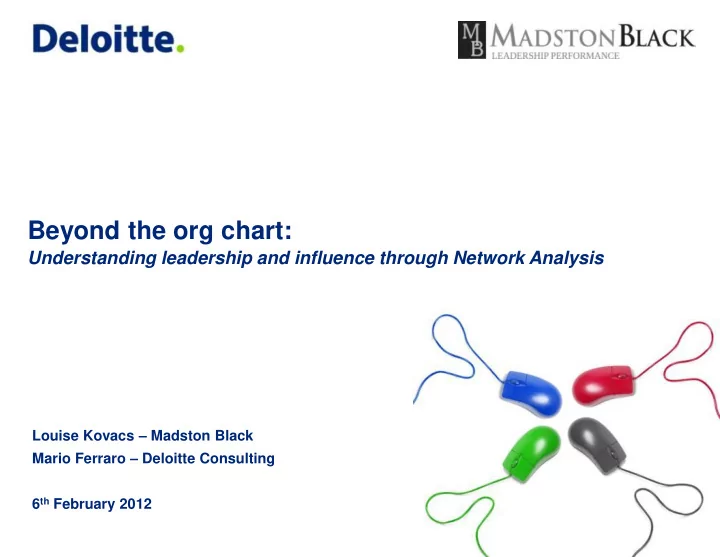

Beyond the org chart: Understanding leadership and influence through Network Analysis Louise Kovacs – Madston Black Mario Ferraro – Deloitte Consulting 6 th February 2012
Why analyse networks? • Huge investment of time designing org structures and org charts, often with disappointing results • The informal organisation usually doesn’t receive enough attention • Informal networks can exist between functions, divisions and Business Units • Informal networks can bypass formal reporting structures to get results quickly • Informal networks can also sabotage or jeopardise initiatives • Mapping these informal networks can help harness the real power and full potential of the organisation Org Chart : Skeleton = Informal Network : Central Nervous System 2
Understanding leadership and influence dynamics Network analysis can help us: • Understand the sources and distribution of power • Assess leadership potential • Lead change • Recruit and retain • Foster innovation • Enhance collaboration to achieve results 3
How does it work? • Identify social groups linked by work, friendship, influence or communication relations • Analyse the relative position of each “actor” within each group Fundamental parameters: Aspects of “Centrality” • Degree Centrality : Number of ties between an actor and other actors • Closeness Centrality : Distance from each actor to all others • Betweenness Centrality : Positional advantage from being on the shortest path between other pairs of actors Typical roles: • Central Connector : Link most people within a network • Boundary Spanner: Connect a network to other part of the organisation or other networks • Information Broker: Keep different subgroups within a network together • Peripheral Specialist: Accessible to all network members for specialist expertise 4
Data sources • Network surveys (employee questionnaires) Who talks to whom Who trusts whom Who advises whom on technical matters Managers’ impressions of informal networks Other data sources: • Email traffic • Telephone traffic • Social Network traffic • Attendance records • Information can be processed with several commercially available tools (e.g. UCINET, Pajek, Visone, etc.) 5
What do we look for? • Formal structures • Communication Networks • Advice Networks • Trust Networks Other features to look for: • “Imploded Relationships”: Groups and departments with few links to other groups. Isolation and “silos syndrome” • Irregular Communication Patterns: Staff communicate more with external groups than among themselves. Lack of cohesion • Fragile Structures : Critical communication links between teams that need to collaborate are tenuous • Holes in the network: Missing critical links • “Bow ties” : Many players dependent on a single employee, who has great power and control 6
Measuring connectedness and influence Based on Deloitte’s internal Social Network platform (Yammer) The wheel demonstrates that Yammer has connected numerous groups which might not otherwise have been connected. Influence can be measured by responses to posts. 7
Overlaying Network Analytics with Text Analytics Mapping the ebb and flow of the information flowing through a network New York City’s 311 information & complaint hotline: 8
Text Mining and Sentiment Analysis Identifying the leaders and influencers, together with insights into the sentiments of specific employee segments, allow proactive interventions. 9
Leadership and Networks 10
Do networks matter? Recently promoted VPs had Top 20% of sales qualitatively different networks to people had better those not promoted networks High performing MDs had 20% more ties and these connections bridged regions, functions, Researchers with better networks had higher rate of innovation and more successes 11/11
3 elements to high performers’ networks Structural Relational Behavioural Authentic Find ways of Span the leaders extending their organisation in capacities important ways Invest in developing Seek Cross functions relationships complementary Tenure before they are expertise Specialists needed Geography Sharing their Not knowledge transactional 12/11
Using ONA for talent management and leadership development Personal network reports Productive networks high- Networks and ONA part of potential criteria curriculum Identify hidden talent Succession planning Provide opportunities for Programmes facilitate successors to develop making relevant network connections Re-measured regularly 13/11
Using Network Analysis 14/11
Using Network Analysis 15
Network type matched to problem 16
Problem solving 17
Louise Kovacs - CEO Mario Ferraro – Director Human Capital lkovacs@madstonblack.com.sg maferraro@deloitte.com
Recommend
More recommend